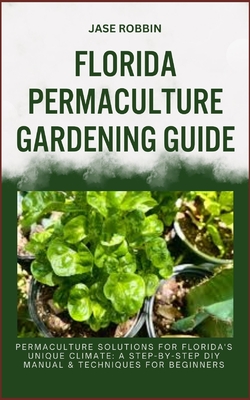You are here
Back to topFlorida Permaculture Gardening Guide: Permaculture Solutions For Florida's Unique Climate: A Step-By-Step DIY Manual & Techniques For Beginners (Paperback)
$12.18
Usually Ships in 1-5 Days
Non-returnable item. All sales final.
Non-returnable item. All sales final.
Description
"Permanent agriculture" and "permanent culture" came together to form the term "permaculture," a method of sustainable and regenerative agricultural practices and human settlements. By studying and imitating natural patterns and ecosystems, adherents of permaculture aim to build human settlements that are both sustainable and harmonious.
Important aspects of permaculture encompass:
- The foundation of permaculture design is careful observation of natural patterns and ecosystems. Learning about the interplay of flora, fauna, soil, water, and weather is a part of this.
- Design: Permaculture places an emphasis on well-planned designs to establish systems that are long-lasting, effective, and resourceful. Think about zoning, do a sector analysis, and put things where they can do the most good when you're designing.
- Utilization of Natural Patterns: Permaculture promotes practices that are reminiscent of nature, such as utilizing water flow for irrigation, incorporating animals into farming systems, and using companion planting.
- One of the most important aspects of permaculture is biodiversity. A system's resistance to pests, illnesses, and environmental changes can be enhanced by incorporating a diverse range of plants and animals.
- Integration: Permaculture advocates for the harmonious coexistence of all parts of a system. When used in gardens, chicken tractors can do double duty as insect controllers and soil fertilizers.
- To save energy, permaculture tries to cut down on waste while making the most of renewable resources. Making effective use of energy and requiring few external inputs are key components of such systems.
- Create Small-scale, Intense Systems: Permaculture frequently entails developing systems that are small-scale and intensive, allowing for the management of limited resources. This goes against conventional farming methods that rely on extensive use of natural resources.
- The focus of permaculture extends beyond the design of landscapes to the development of human societies that can withstand environmental stresses in the long run. As part of this effort, we must encourage responsible and ethical conduct, build stronger social bonds, and pool our resources.
Many fields and activities can benefit from permaculture practices, such as food production, landscaping, building design, water conservation, and community building. The objective is to design eco-friendly technologies that can withstand and even thrive in harsh environments. Permaculture is an all-encompassing method that aims to build regenerative and sustainable solutions by acknowledging the interdependence of all parts in a system.
